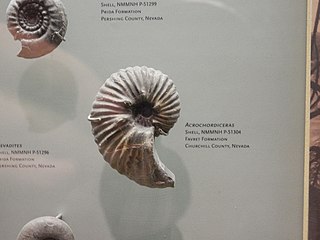
Acrochordiceras is a genus of Middle Triassic ammonoid cephalopods belonging to the ceratitid family Acrochordiceratidae, included in the superfamily Ceratitoidea.

Anahamulina is an extinct ammonoid cephalopod genus from the Lower Cretaceous. Named by Hyatt, 1900.

Coilopoceratidae is a family of generally large, proper ammonites with strongly involute shells from the Cretaceous, Albian to Turonian. Coilopoceratids have variably compressed shells with flattish to broadly rounded sides and narrowly rounded to sharp keel-like venters. Whorl sections are generally lanceolate. The suture is ammonitic with an overall clumpy appearance.

Parahoplitidae is an extinct family of Cretaceous ammonites with stoutly ribbed, compressed, generally involute shells lacking or with only minor tubercles included in the Deshayestoidea, a superfamily now separated from the Hoplitacaceae.

Acanthoceratidae is an extinct family of acanthoceratoid cephalopods in the order Ammonitida, known from the Upper Cretaceous. The type genus is Acanthoceras.

Goniatitina is one of two suborders included in the order Goniatitida; extinct Paleozoic ammonoid cephalopods only distantly related to the Nautiloidea.
Tornoceratidae is a family of goniatitid ammonoids from the middle and upper Devonian. The family is included in the suborder Tornoceratina and the superfamily Tornoceratoidea.

Medlicottiidae is a family of ammonoid cephalopods belonging to the Prolecanitida, known from the Upper Carboniferous (Pennsylvanian) to the Early Triassic.
Haploceratoidea, formerly Haplocerataceae, is an extinct superfamily of ammonoid cephalopods belonging to the Ammonitida that unites three families, Strigoceratidae, Oppeliidae, and Haploceratidae, listed below.
Ancyloceratoidea, formerly Ancylocerataceae, is a superfamily of typically uncoiled and loosely coiled heteromorph ammonoids established by Alpheus Hyatt in 1900, that may contain as many as 11 families, depending on the classification accepted.
The Ophiceratidae is a family in the ammonoid order Ceratitida from the Lower Triassic, previously included in the Otocerataceae but now placed in the Noritiaceae as revised.

Clymeniida is an order of ammonoid cephalopods from the Upper Devonian characterized by having an unusual dorsal siphuncle. They measured about 4 cm (1.6 in) in diameter and are most common in Europe, North Africa, and South China but are known from North America and Australia as well.

Oxynoticeratidae is a family of true ammonites included in the superfamily Psiloceratoidea.
Microderoceras is a flat sided, evolute, radially ribbed Lower Jurassic ammonite belonging to the ammonitid family Eoderoceratidae and superfamily Eoderoceratoidea. Its whorls are subquadrangular in section; venter on the outer rim, rounded; sides with two rows if distinct spines, tubercles on internal molds, formed at either end of the ribs. The lateral surface of the ribcage is concave toward both sides, the lateral side of the dorsal and the lateral side of the ventral surface. The ribs are divided into six pairs (1-3) of the following types: 2-3 is the only type. In the first type, the ribs on the ventral face are fused to the ribs on the ventral sides; the ribs on the dorsal face are fused to the ribs on the dorsal sides. The second type represents the ribbed body, the ribs are in the same arrangement as in the first type and the rib cage does not fuse to the dorsal surface.
Inyoites is an ammonoid genus from the Lower Triassic, included in the ceratitid family Inyoitidae.

Neocomitidae is a family of Lower Cretaceous ammonitids comprising genera with strongly ribbed evolute to smooth, fairly involute shells.

The family Dactylioceratidae comprises Early Jurassic ammonite genera with ribbed and commonly tuberculate shells that resembled later Middle Jurassic stephanoceratids and Upper Jurassic perisphinctids. Shells may be either evolute or involute.

Pulchelliidae is an extinct ammonoid cephalopod family. It was previously classified as belonging to the superfamily Endemoceratoidea. They lived during the Cretaceous, in the Barremian age.

The Acanthoceratinae comprise a subfamily of ammonoid cephalopods that lived during the Late Cretaceous from the latter early Cenomanian to the late Turonian

Diplomoceratidae is a family of ammonites included in the order Ammonitida. Fossils of species within this genus have been found in the Cretaceous sediments. Studies of Diplomoceras suggest that members of this family could reach lifespans of over 200 years.














